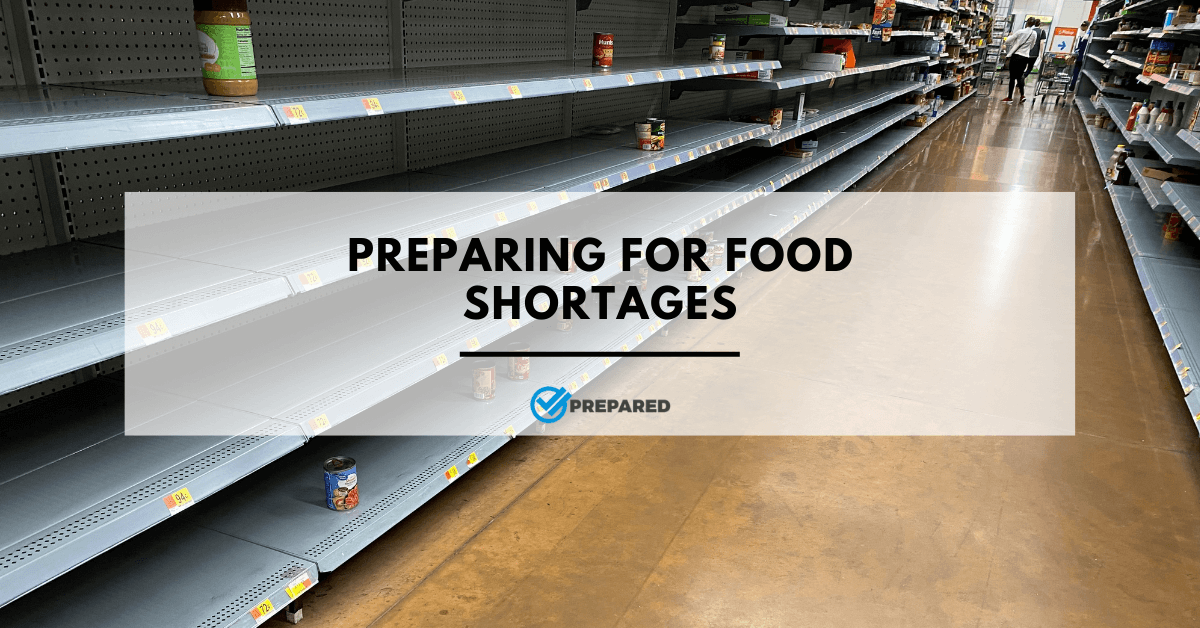The Covid-19 pandemic didn’t only produce a shock in terms of a health crisis. For the first time in living memory, it revealed just how vulnerable the US food system is to shortages caused by disruptions at any point in the supply chain. In this post, I will consider how to prepare for food shortages.
Causes of food shortages
Food shortages weren’t only the result of loss of production on farms as workers fell sick and crops went unharvested. With the closure of stores and other food outlets, demand for certain produce fell dramatically and producers weren’t agile enough to adapt and find alternative buyers. Farmers were forced to destroy crops and livestock which they were unable to sell.
As Covid spread among meatpackers, unanticipated bottlenecks were created which prevented products from reaching the grocery store shelves. Although we are all hoping that the worst of the pandemic is over, farmers are sounding the alarm that further, more serious food shortages could be on the horizon.
Further disruptions to the food supply chain?
The supply chain can also be disrupted by catastrophic flooding, destructive hurricanes, and raging wildfires. State-wide power outages or cyber-attacks could also create major disruptions to food distribution. Once communication systems go down, food processing and distribution would be impacted, leaving consumers vulnerable to shortages as wholesalers are unable to keep retailers stocked with the products we’re used to.

The inability to get food to where it needs to be is a major cause for concern. Shocks in terms of rocketing fuel prices, or a lack of manpower to drive trucks or stock warehouses could mean that food availability cannot be guaranteed. And as we saw at the start of the pandemic, when people feel insecure about whether they’ll be able to feed their families (and keep their homes clean), they respond by stockpiling. Stores, unprepared for unseasonal spikes in demand, increasingly find themselves with gaps on their shelves.
Overall, the food system in the USA is woefully unprepared to respond with a ‘Plan B’ for when the next crisis inevitably hits us, and more people are asking how to prepare for food shortages.
Which products might be impacted?
Americans are already accustomed to occasional shortages of their favourite foods – something that wouldn’t have been dreamed of even a couple of years ago. But as we head into the winter season, it’s being predicted that certain foods that most of us rely on may be in shorter supply than we typically expect.
- Canned Goods: These could be in short supply, but not directly because of a shortage of food. Aluminium, which is also used in the packaging of soda and teas, has seen a price increase of over 40% since January 2021. This hike is likely to be passed on to consumers.
- Meat and Poultry: While there is still plenty of livestock available, in the aftermath of Covid, many meat processors are still working at less than their full capacity. While prices have moved slightly downwards, it may be a good idea to place orders for the holiday period in advance. If necessary, you can freeze your meat to ensure you won’t be caught out by sudden shortages or hikes in the price. However, there is no immediate crisis and no need for panic buying – which could in itself cause prices to rise.
- Fish: Retailers are reporting hiccups in the supply of fish, due to a shortage of dockside labour available to unload the ships.
Given the above, how can you prepare for food shortages?
How to prepare for a food shortage?
Once you’ve decided that it would be prudent to plan so that you and your family would be secure in case of a calamity, there are several steps to take. A systematic approach will pay dividends in the long run.
You’ll have peace of mind knowing how to prepare for food shortages, and that your family will not go short of food. You’ll save money by buying in quantities that you’ll consume without waste. And by storing a rational amount of food, you won’t be contributing to panic buying and shortages.
How can families prepare for a food shortage?
The first step is to monitor your family’s overall food consumption, for at least a month. By the end of this period, you’ll have an idea of the quantity of food you’d need to keep you going for at least that long. Next, think about the essentials for each family member- for example, baby food and milk. If anyone has special dietary needs ensure that these are taken care of. And don’t forget your pets.
Also see: Survival Gardening for Beginners
Then take into account each person’s preferences – this will help ensure that the stocked food is actually consumed and as little as possible goes to waste. If your family loves pizza and pasta above all else, sacks full of organic quinoa are unlikely to delight them. Go for a rational mix of the practical and the pleasurable. Armed with your analysis, and keeping in mind the storage space you have available, you’ll be in a great position to create your list of essentials.
What are the best food products to buy?
What type of products can you consider when preparing for possible food shortages?
- Canned or bottled goods: Vegetables, fruits, beans, and other canned or bottled goods can last up to five years.
- Meat: Stocking your freezer with a supply of frozen meats will mean you have the basis for protein-rich meals. It’s best to cut it into small pieces and remove it from the bone. This will ensure it will freeze faster and you’ll be able to defrost in meal-sized quantities.
- Rice: Brown rice is richer in nutrients and fibre than white rice and is a great addition to your store. It’s a good idea to start incorporating it into your regular meals so your kids get used to the nutty texture. However, be careful, the oils in the husks of long-grain or wild varieties can go rancid. White rice often has a longer shelf life.
- Beans: Dried beans are also rich in proteins and micro-nutrients and can be stored for up to 10 years.
- Pasta: Dried pasta can last for up to 20 years, so if your family loves it, stock up.
- Eggs: Packed with nutrients, eggs will last up to a year when stored in the freezer
- Vegetables: Frozen vegetables can last for several years in the freezer. They’ll make a welcome change from canned alternatives.
- Coffee and teas: The flavour will gradually fade, but dividing into small airtight containers and keeping them out of the light will slow the process.
- Salt and other condiments: Consider how long your current stock would last and top up if needed. Salt will never go off, just keep it dry. Slow the deterioration of bottled herbs by keeping them in a cool, dark place.
- Vitamins & mineral supplements: To ensure that the family has all the nutrients they need to stay healthy. In addition to a multivitamin/mineral combination, consider adding an omega 3 supplement as it plays a beneficial role in many bodily functions.
- Miscellaneous Items: Other items which may be useful include dry cereals (oats, barley), fruit or protein bars, and long-life (UHT) milk. Also, include occasional treats such as chocolate and cookies which also have an extended shelf life if stored correctly.
Conclusion
If the likelihood of major food shortages in the future has got you thinking about how you can prepare your family to survive in case of a crisis, then now is the time to get a plan in place. You can get started with the help of some great resources. For example, Daisy Luther’s guide “Prepper’s Pantry: Build a Nutritious Stockpile to Survive Blizzards, Blackouts, Hurricanes, Pandemics, Economic Collapse, or Any Other Disasters”, contains shopping lists and even meal plans to make life easier for you.
Also See: 5 Reasons To Consider Freeze-Dried Food
Or if you’re looking to get your emergency food stockpile off to a great start, why not buy some easy-to-prepare ready meals? The ReadyWise Emergency Food Supply Organic Breakfast and Lunch Variety Pack provide you with delicious freeze-dried meals that only need hot water and they’re ready to serve. It requires very little storage space, contains 90 servings, and has a shelf life of up to 25 years. Of course, we all hope that the worst will never happen. But if it does, we can at least have the peace of mind knowing that we’ve taken responsible precautions to ensure that our loved ones will emerge from the crisis, safe and well-fed.

Chris was born and raised in South Africa and has worked in the field of risk management, organisational resilience, and business continuity for more than a decade. During his career he has seen how private and public sector organisations benefit from effective risk management and business continuity planning. Realising that families and communities can also benefit from the same tools, methodologies, and principles, he started Prepare with Foresight.
Prepare with Foresight was launched to assist individuals and families to have the peace of mind that they will be able to recover from and successfully adapt to the consequences of adverse events.

